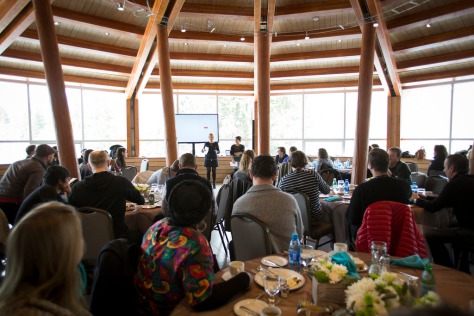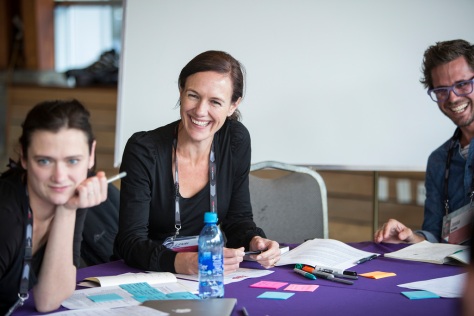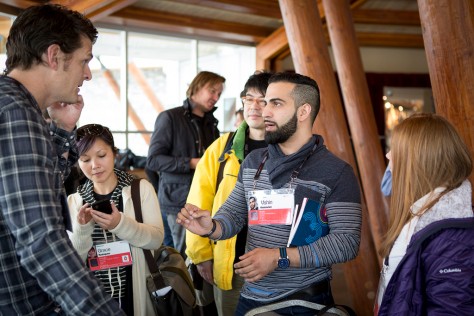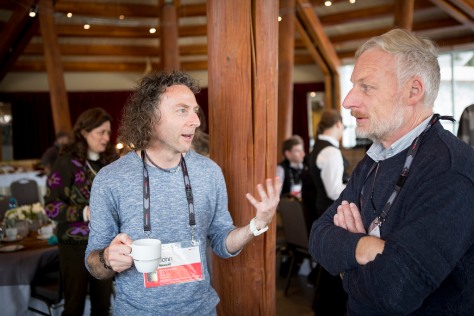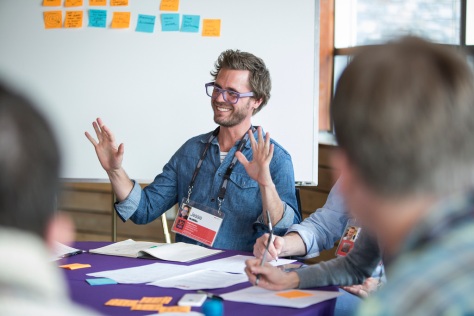“We’re all gathered here to celebrate Ads Worth Spreading,” announced co-hosts Cindy Gallup and Abigail Posner, dressed head to toe in Zara, or “recession-chic” as they called it. “We are going to see the creative approach about how we think TED can spread its own ideas.”
But the conversation quickly took on a bigger and broader question, as conversations at TED often do. What we were really here to talk about, Cindy revealed, is what the future ads worth spreading will be.
Earlier in the week, Google’s Creative Director Ben Jones had discussed the opportunity to create impactful and meaningful content within the context and the mediums that the world of digital media has to offer. What happens when we ask people the really fundamental questions, like the Doador Sport Campign, for example? How can we create structures that people can and want to participate in, with platforms like Kiva or calls to action like Amanda Palmer’s TEDTalk? How might we create brand ambassadors though the content we create, as Heineken has done with its #Dropped experiment? With so many new kinds of content and mediums with with to capture peoples’ attention, Ben says, “amazing is always on the other side of yes.”
So what should advertisers be saying yes to?
“We need to delve deeper into the nature of our relationship to the different digital spaces that we play in,” Abigail says. Instead of just putting content on a mobile screen, she explains, how can we leverage the insight that mobile is a way for us to build and share culture?
From Cindy’s perspective, we also need to be saying yes to advertising. She points to an almost universal, fundamental belief that advertising is a bad thing. This belief, she points out, exists here at TED, among consumers of advertisments, and among advertisers themselves. We can’t leverage the great things technology and creativity have to offer if we continue believing this to be true, she notes. “The future is about creative collaboration in a way that assumes positive intent on both sides, and that enables us to do our best work together,” says Cindy. “Despite what everybody else thinks, we absolutely have the ability to change the world, just as much as any other speaker you’ve seen on stage this week.”
Over the course of this week at TEDActive, advertising gurus, AWS nominators and judges, as well as the winning ads themselves, came together around TED’s Ads Worth Spreading initiative to think about creating some new ads worth spreading to solve some of TED’s biggest challenges. Ads Worth Spreading began in 2011, to “recognize and reward innovation, ingenuity and intelligence in advertising,” that is, ads that spread an idea through powerful and meaningful connections with their audience. This year, ten winners embodied powerful and transformative work with the power to change the world. You can watch the winning pieces here.
With facilitation led by IDEO, winners, nominators and leaders alike, split into three teams, each handed a brief and three days to design a compelling pitch, the winner of which would be awarded $25K in seed funding by TED to bring this idea to life. The outcome reflected the curious, innovative and proactive spirit that TEDActive is all about.
Think Globally, Act Locally
Create a campaign that tells people how to become a part of the volunteer community of TEDx.
How can TED better tell the stories of local change and engagement? How can we reach everyone who wants to get involved with TED and make a difference in their communities?
Tom Wong (TBWA) and Ben Jones (Google) presented for the group. Ben shared how during dinner the night before, he sat next to Ilwad Elman, a young woman who grew up in Ottowa, but returned to her home country of Somalia after the assassination of her father, to carry on his human rights work with her mother through their Elman Peace and Human Rights Center in Mogadishu, and has used the TEDx platform to connect with her community and others around her ideas. “This isn’t just playing around with a brief,” says Ben. “This is incredibly, incredibly important.”
TEDx is a great gateway product to get involved with a much larger brand, explain Tom and Ben. “We want to help turn TEDx organizers from a power to a great big superpower. Local action, global impact.” This group had several concepts, including TEDxMe, which makes everyone a TEDx organizer at an atomic level and lowers the barrier so that anyone can immediately do so through personalized TEDx playlists. Another, called TEDxEveryday filters personally-tailored TEDx talks to the user based on the amount of time they have to watch. A third (and there were several beyond this) entitled BatSignal, was a way to connect TEDx communities to help each other with common challenges. This collection of offerings centered around a core belief that “local is not measured from where my feet are, it’s measured from where my heart is.”
Youth and Education
Design a strategy to help create awareness of the TED-Ed ecosystem and its potential.
How might we reimagine the current TED-Ed videos to reach the common person, strike chords in people, and generate emotional investment?
John Mescall (McCann Australia) and Kate Smither (Ogilvy & Mather) shared a plan for unlocking the TED-Ed potential. “There are 2 billion youth in the world. They’re curious souls, but they’re at a time in their life where they’re put into a school system, told to be less curious, not ask why or why not.” From ages 0-9 and 18-18, we’re told to go out and try things, make things, do things. But from ages 10-17, we’re told to sit, be patient, absorb, and wait. Where TED-Ed can play is in this middle section, where students are made to wait.
You’re not ready. Wait your turn. Pay your dues. You’re just a kid. This is the message we’re telling kids at a time when they’re most excited about the world. What we need to tell them, say Kate and John, is to be impatient. “If you have something inside of you, go learn about it, go do it. You do not need to wait your turn or be taught something by the system.” What their team created was an unlockable device, aimed at 14-year olds. To unlock it, you need to know something you might not traditionally know until age 17 or 18. You can wait to play the game until then, says John, or you can be impatient and use TED-Ed to learn what you need to know to unlock it. “Kids have never been more ready to blaze their own trail and make their own destiny.” And here’s how.
The Ripple Effect
Tell the story of the ripple effect of one idea, to inspire others. And build a clear incentive for people to push ideas forward.
How might we amplify an idea that can change the world, bring it to the attention of people with the ability, drive and imagination to make a difference?
When an idea worth spreading spreads, what does it create? Georgia Challis (Wieden & Kennedy) and Jesse McMillin (Virgin America) presented for their group. “TED is about ideas worth spreading – big, inspiring, touching, brain-expanding ideas. They’re so big, they can feel daunting to the rest of us.” How do we help those of us who aren’t going to stand on the TED stage understand the key role they have in spreading an idea. How do we compel them to be more than just viewers?
Georgia takes us through their treatment, a action-inspiring piece that shows the impact that sharing can have on the proliferation of an idea. We see a speaker on the TED stage, ready to begin a talk, but seemingly struggling to begin. Then we see someone share his talk online and he begins to proceed. Then another, then another. The shares are powering his talk, making him come alive. “It takes many people to deliver a TEDTalk,” says Georgia. “One person stood on stage, a million people spoke. Share TED.”
After each pitch had been presented, the group talked about the potential for implementation of each idea. Not able to decide on a final one (they were all so great!), the folks at Ads Worth Spreading decided to take the ideas back into TED for further discussion. Stay tuned!


